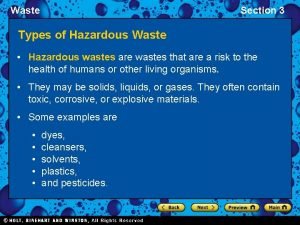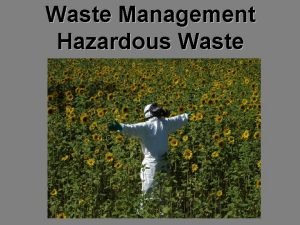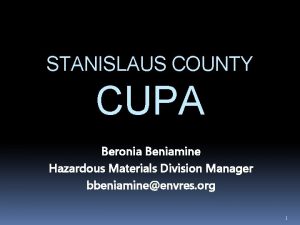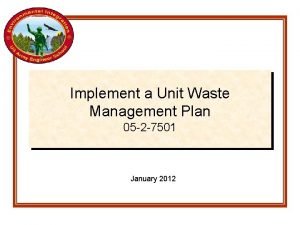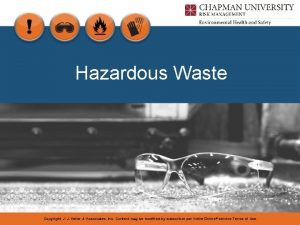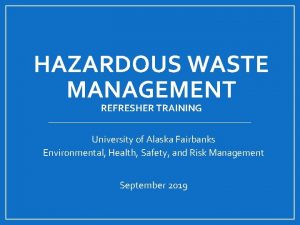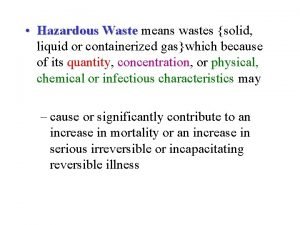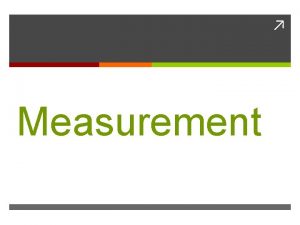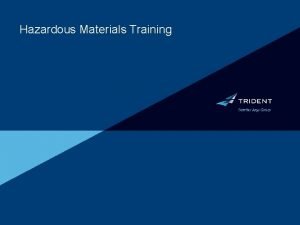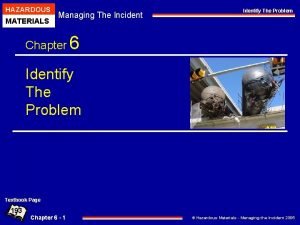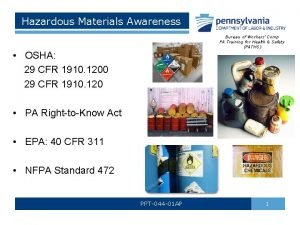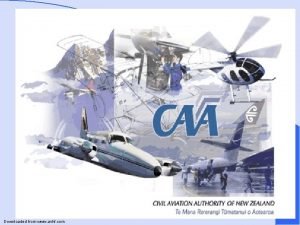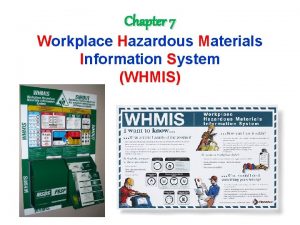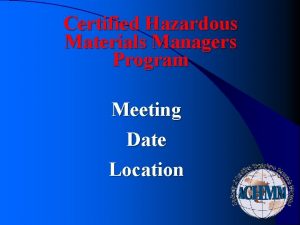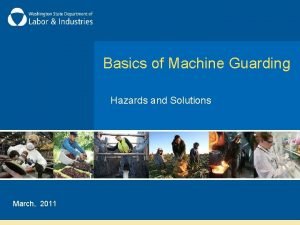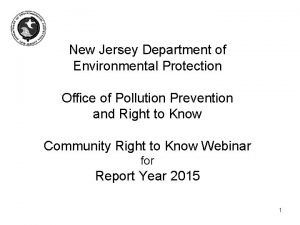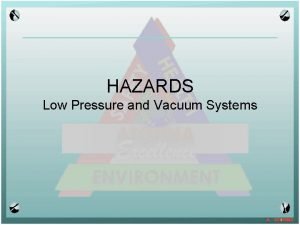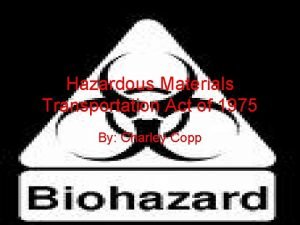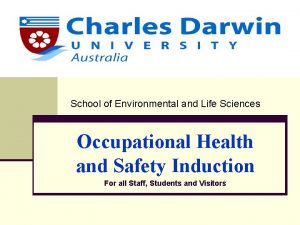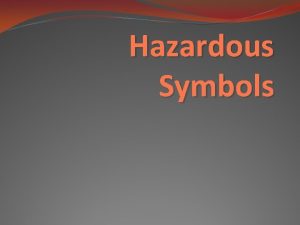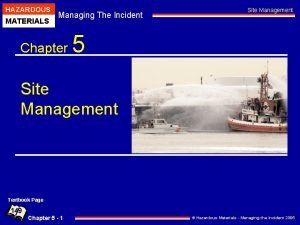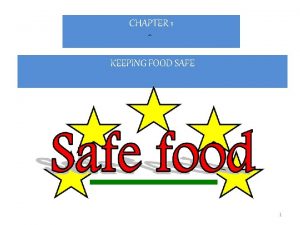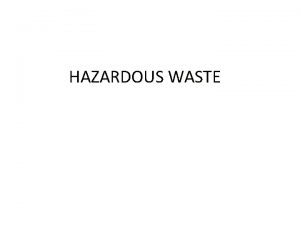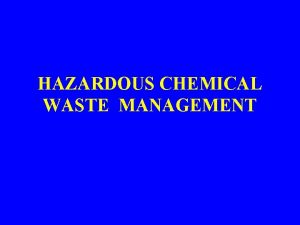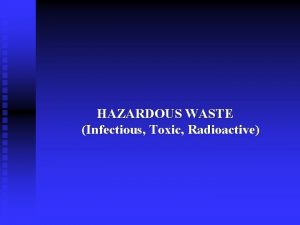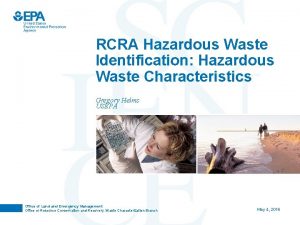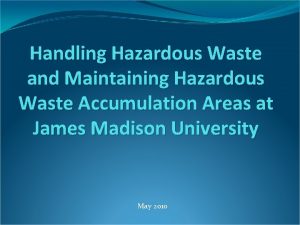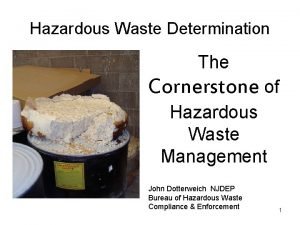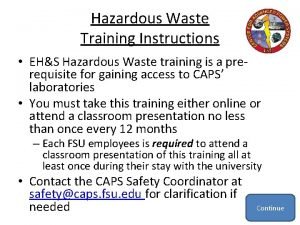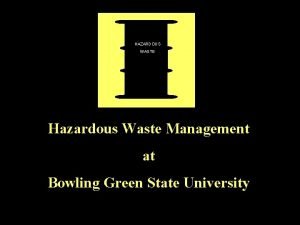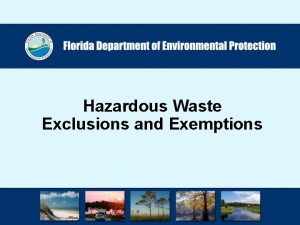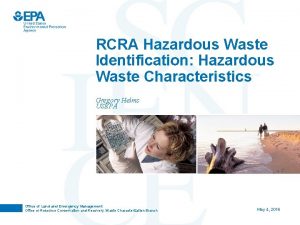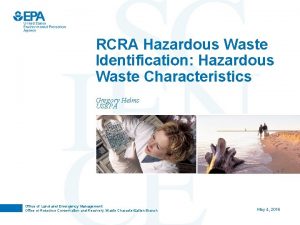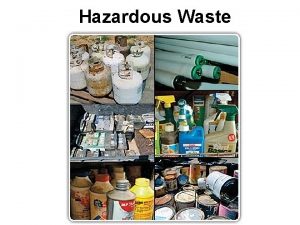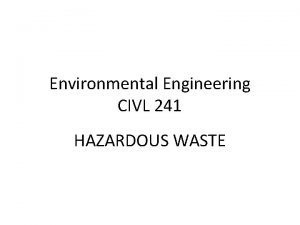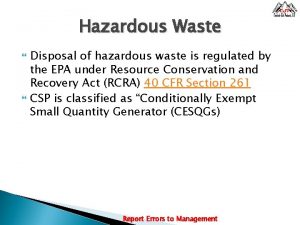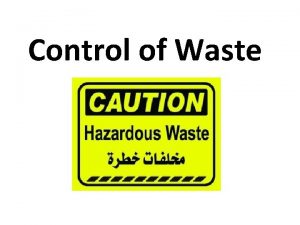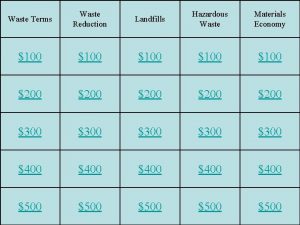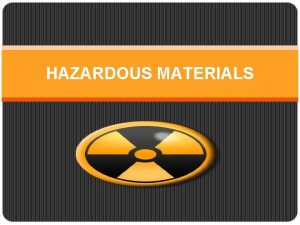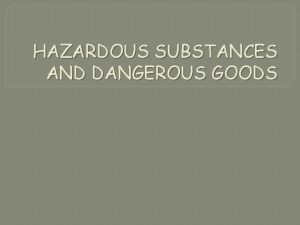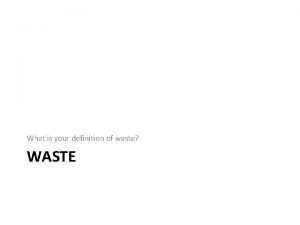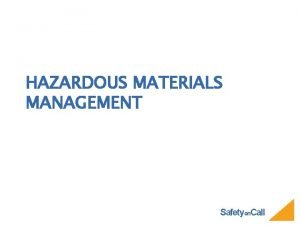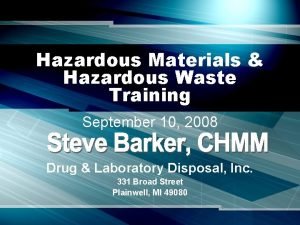HAZARDOUS WASTE 4 6 DEFINITION Hazardous waste means































- Slides: 31

HAZARDOUS WASTE

4. 6 DEFINITION Hazardous waste means wastes (solids, sludges, liquids and container gases) other than radioactive (and infectious) wastes, by reason of their chemical activity of toxic, explosive, corrosive or other characteristics cause danger or likely will cause danger to health or the environment, whether alone or when coming into contact with other waste - United Nations Environment Programme (UNEP) (1985)

Hazardous waste is any waste or combination of wastes which pose a substantial present or potential hazard to human health or living organisms because such wastes are lethal, non-degradable, persistent in nature, biologically magnified or otherwise cause or tent to cause detrimental cumulative effects. - United States Environmental Protection Agency (USEPA) Toxic and hazardous wastes are wastes or combination of wastes that pose a significant present or potential hazard to human health or living organisms, and are included in ‘Scheduled Wastes’ - Department of Environment (DOE), Malaysia (1995) There are 107 categories of ‘Scheduled Wastes’ and these include wastes generated mainly from petroleum and oil refineries, pharmaceutical, rubber processing, chemical and electronics and semiconductor industries

Classification of hazardous waste Two basic approaches Listing approach Criteria approach Listing by source Candidate waste streams are reviewed by source and segregated into hazardous and non-hazardous categories

Advantages Ease of implementation and enforcement Once wastes have been designated, the wastes can be readily categorised by source. Generators and regulators can quickly determine the status of waste without performing any test Cost associated with identification of hazardous waste is low Disadvantages Ignores the reality that waste from two generically similar sources may have greatly different properties Does not accommodate new wastes or combination of wastes Periodic evaluation of wastes to reaffirm or change designation is necessary

Listing by pure compound Selected list of hazardous compound is developed Wastes that contain any of these compounds are designated hazardous Advantages Data on most of the selected compounds are readily available in the literature Literature data is used and waste analysis is reduced to chemical characterization Costly hazard testing is eliminated Disadvantages Its assigns properties of single constituent to a complex waste mixture, thus fails to account for interactions between various constituents – alter the hazardous nature Mixture of non-hazardous compounds may react to produce a hazardous product in a waste

Criteria approach Quantitative approach May be applied directly to wastes or to chemicals for selection of entries in the compound list Based on comparison of specific material characteristics to a selected threshold value Threshold exceeded – material is hazardous Advantages Can be applied to future waste as well as currently generated Test are run – pass or fail based on intrinsic properties Disadvantages Cost and time associated with testing

Characteristics of hazardous waste Indicative criteria: Toxicity Flammability Reactivity Corrosiveness

Toxicity Ability of a waste to produce injury upon contact with a susceptible site in or on the body of a living organism. Acutely or chronically toxic Acute toxicity effects within hours of exposure of inhalation or after a single dermal or oral dose Chronically toxic contain materials that are bioaccumulated in the food chain or cause irreversible damage Gradually to a final unacceptable level E. g. heavy metal and halogenated aromatic

Flammability Pose both acute handling hazards and latent disposal hazards Handling involves safety hazards to personnel at the site of origin, during transport and disposal sites Latent hazard – potential damage caused by unintentional or spontaneous combustion of flammable residue at disposal sites Flammable wastes – solvents, oils, pesticides, plasticizers and complex organic sludge Flash point – min T at which liquid produces a sufficient concentration of vapour above it, forms an ignitable mixture with air Auto-ignition temperature - lowest T at which a material will spontaneously combust in a normal atm, without an external source of ignition, such as a flame or spark

Reactivity Can threaten life and property in an acute as well latent way Handling, shipping or disposal operation can initiate violent reaction – explosion Reactive materials buried in a landfill may detonate later when the conditions are appropriate Extreme hazard group of materials includes: Materials that can be detonated by electrostatic charge Oxidising materials e. g. chlorates, perchlorates, bromates, peroxides, nitrates, permanganates Self reactive materials Materials capable of autopolymerisation Primary explosive – detonated by friction, impact, shock, heat Materials that can react violently with water or air

Corrosiveness Ability of one agent to eat away or erode another material through chemical action Largely evidenced during handling and storage Release of the corrosive material itself and opportunity for the corrosive material to release other hazardous wastes Materials considered corrosive: Aqueous material whose p. H ≤ 2 Aqueous materials whose p. H ≥ 12 Liquids which corrode steel at a rate > 0. 625 cm/year at 55ºC

Hazardous waste in Malaysia The Department of Environment (DOE) is empowered under the Provision of the Environmental Quality Act 1974 to control and prevent pollution and protect and enhance the quality of the environment Regulations dealing with hazardous waste management: 1. Environmental Quality (Scheduled Waste) Regulations, 1989 2. Environmental Quality (Prescribed Premises) (Scheduled Wastes Treatment and Disposal Facilities) Regulations, 1989 3. Environmental Quality Act (Prescribed Premises)(Scheduled Wastes Treatment and Disposal Facilities) Order, 1989

Regulations specified following requirements: a) b) c) d) e) f) g) h) As far as practicable, scheduled wastes shall be rendered innocuous before disposal Generation of scheduled waste shall be reduced using best practicable means Waste generators to notify the DOE of any scheduled wastes generated and keep up to date inventory of scheduled waste generated, treated and disposed of Scheduled wastes may be stored, recovered and treated within the premises of a waste generator Land farming, incineration, disposal, off-site recovery, off-site storage and off-site treatment shall only be carried out at prescribed premises licensed by DOE Durable waste containers with clear labels shall be used and storage of wastes shall be proper and adequate Waste generators shall conform to the requirements of the consignment note system when transporting wastes to ensure it reaches the approved destination and are carried out by licensed transporters Waste generators shall provide information to the transporters regarding the nature of the wastes and action to be taken in case of accidents

Based on the physicochemical and toxicological properties of the contents and using the First Schedule of the Environmental Quality (Scheduled Wastes) Regulations 1989 as a guideline, hazardous wastes can be broadly classified according to the various chemical groups as follows (listing approach) a) Mineral oils (machine and cutting oils) pitch and tar (polycyclic aromatic hydrocarbons) Haloganated organic solvents e. g. trichloroethylene Photographic developers e. g. paraphenylendiamine Alcohols e. g. methanol Aromatic solvents e. g. benzene, toluene Ketones e. g. acetone Formaldehyde Polychlorinated biphenyls (PCB) Mineral acids and alkalis Heavy metals Arsenic Cyanide Herbicide and pesticides Asbestos-cement fibres Biological wastes b) c) d) e) f) g) h) i) j) k) l) m) n) o)

Site for a Hazardous Waste Management Facility Site selection Located at a site that by virtue of its natural features and land use setting provides a high degree of protection to public health and the environment Proximity to sources 3 phases Phase I – Regional screening (to search areas) Phase II – Examination of search areas (to identify candidate sites) Phase III – Detailed evaluation of candidate sites (for final site selection)

Site and subsurface characterization Required to know what lies on and beneath the site of a hazardous waste management facility Involves a number of disciplines including geology, hydrology, chemistry, biology, geotechnical engineering Insufficient or incorrect site and subsurface characterization can lead to inadequacies in design, engineering and/or siting of hazardous waste management facilities Subsurface characterization must clearly define the site’s 3 dimensional geologic and hydrogeologic characteristics Investigations must show the influence of site and subsurface conditions on the performance of existing and planned hazardous waste management system Investigations must provide information on site history, groundwater flow direction, water quality and quantity, potential contaminant migration

Clinical waste Disposal wastes arising from health care establishments (public and private) can have an effect on The health and human being The environment Issues relating to public safety Guidelines Environmental Quality Act of 1974 which administered by DOE Safety and health features in clinical waste management recommended by Ministry of Health, Malaysia in order to protect health of staff, waste collection workers, patients and general public In Malaysia, clinical waste is classified as scheduled waste under the Environmental Quality (Scheduled Wastes) Regulations, 1989 1. 2. 3. 4. N 251 Discarded drugs except living, vaccines and euphoric compounds N 261 Pathogenic and clinical wastes and quarantined materials N 281 A mixture of scheduled wastes N 282 A mixture of scheduled and non-scheduled wastes

Consideration to manage clinical wastes effectively: Generation and minimization Source separation and segregation Identification and labeling Handling and storage Safe transportation Treatment Disposal of residues (including emissions) Occupational safety and health Public and environmental health Research and development into improved technologies and environmentally friendly practices

A common and internationally accepted definition for waste generated in healthcare facilities Healthcare wastes hazardous healthcare wastes Infectious healthcare wastes Sharps

Identification, classification and waste group Wastes from hospitals and healthcare establishments can be categorized into: ◦ Clinical waste ◦ Radioactive waste ◦ Chemical waste ◦ Pressurized containers ◦ General waste Clinical wastes are containing: ◦ Human or animal tissue ◦ Blood or body fluids ◦ Excretions ◦ Drugs ◦ Pharmaceutical products ◦ Soiled swabs or dressings ◦ Syringes, needles, sharps ◦ Any waste that has come into contact or been mixed with any of the above types of wastes ◦ Waste unless rendered safe may prove hazardous to any person coming into contact with it

Major classification of clinical waste and its recommended management guidance in Malaysia Description Waste management guidance 1. Blood and body fluid waste i. soil surgical dressings ii. material other than reusable linen from cases of infectious diseases iii. pathological waste Special requirement on the management from the viewpoint of infection prevention. This category must be incinerated completely in an appropriate incinerator. 2. Waste posing of injury (sharps) All objects and materials which closely linked with healthcare activities and pose a potential risk of infection and injury Collected and managed separately from other waste. the collection containers must be puncture resistant and leak tight. This category has to be disposed/ destroyed completely 3. Infectious waste Clinical waste arising from laboratories (e. g. pathology, haematology, blood transfusion, microbiology, histology) and post mortem rooms, other than waste included in category 1 waste Special requirement on the management from the viewpoint of infection prevention. This category of waste must always be incinerated completely in an appropriate incinerator

4. Pharmaceutical and Cytotoxic Pharmaceutical Wastes i. Pharmaceuticals which have become unusable for the following reasons: * expiry date exceeded after the packaging has been opened or the ready-to-use preparation prepared by the user, or use is not possible for other reason (e. g. call back campaign) ii. Wastes arising in the use, anufacture and preparation of, and in the oncological treatment of patients with, pharmaceuticals with a cytotoxic effect Class I – pharmaceuticals such as chamomile tea, cough syrup and the like which pose no hazard during collection, intermediate storage and waste management: managed jointly with municipal wastes Class II – pharmaceuticals which pose a potential hazard when used improperly by unauthorized persons: managed in an appropriate waste disposal facility Class III – heavy metal-containing unidentifiable pharmaceuticals: managed in an appropriate waste disposal facility

5. Other infectiouswastes All healthcare waste known or clinically assessed by a medical practitioner or veterinary/surgeon to have the potential of transmitting infectious agents to humans or animals. Used disposable bed-pan liners, urine containers, incontinence pads and stoma bags Disposed of in a hazardous waste incineration plant

Waste segregation Responsibility of nursing and clinical staff to ensure that segregation of clinical waste is carried out at source All clinical waste deposited only in yellow bags Sharps in sharp bins only Colour coding Black – general wastes Yellow – clinical wastes for incineration only Light blue – wastes for autoclaving or equivalent treatment before ultimate disposal

Labeling and marking Writing the information on the bag or container Using pre-printed tape Using pre-printed self adhesive address labels supplied on a peel off roll Tie on tag label, with the information written on them Self locking plastic tags, pre-printed with all the required information

Handling, storage and internal transportation Manual handling of waste bags should be minimized The necks of waste bags should be positioned to allow access for further movement All clinical waste bags should be handled by the neck only The bags and containers containing clinical waste from initial storage should removed regularly Double yellow bags shall be used for clinical wastes from high risks areas Syringes with attached needles shall be discarded into sharps containers as one unit Internal passage routes shall be designed to minimize the passage of waste through patient care Dedicated trolleys or wheeled containers to transport waste container

Personal Protective Equipment (PPE) Used for health protection and safety of personnel handling/dealing with hazardous waste To avoid acute exposure and minimize the risk of long-term, chronic health problems Potential health and safety problems: ◦ ◦ Exposure to toxic chemicals Electrical, fire, explosion and other safety hazards Exposure to extremely high or extremely low temperature Exposure to high noises levels Degree of risk depends on the magnitude and duration of exposure PPE is a control measure to minimize personal exposure when it is not feasible to control risks by engineering control PPE does not eliminate hazard and it is a last line of defence The use of PPE may introduce additional hazards to the wearer by interfering with one or more of the senses

Eye, ear and skin protection

Respiratory protection

Foot protection
 Section 3 hazardous waste answers
Section 3 hazardous waste answers Biomedical waste management introduction
Biomedical waste management introduction Msw apes
Msw apes Sample of hazardous waste
Sample of hazardous waste Stanislaus county hazardous materials division
Stanislaus county hazardous materials division Waste management references
Waste management references Solid and hazardous waste
Solid and hazardous waste Keller hazardous waste disposal
Keller hazardous waste disposal Hazmat training alaska
Hazmat training alaska Waste means
Waste means Triangle quadrilateral pentagon hexagon octagon
Triangle quadrilateral pentagon hexagon octagon Meta means in metamorphism
Meta means in metamorphism Meta means change and morph means heat
Meta means change and morph means heat Biodiversity and conservation
Biodiversity and conservation Bio means life
Bio means life Aviation hazardous attitudes
Aviation hazardous attitudes Hazardous materials table
Hazardous materials table Hazardous materials table
Hazardous materials table Hazardous
Hazardous Pa-psfa-hazardous materials awareness
Pa-psfa-hazardous materials awareness Five hazardous attitudes
Five hazardous attitudes Hazardous attitudes
Hazardous attitudes Shape and color of whmis 2015 symbols
Shape and color of whmis 2015 symbols Chmm accreditation training
Chmm accreditation training Hazardous mechanical motion
Hazardous mechanical motion Nj crtk environmental hazardous substances
Nj crtk environmental hazardous substances Low pressure hazards
Low pressure hazards Hazardous materials transportation act of 1975
Hazardous materials transportation act of 1975 Hazardous area training darwin
Hazardous area training darwin Hazardous symbols
Hazardous symbols Hazardous materials managing the incident
Hazardous materials managing the incident Keeping food safe chapter 1
Keeping food safe chapter 1
